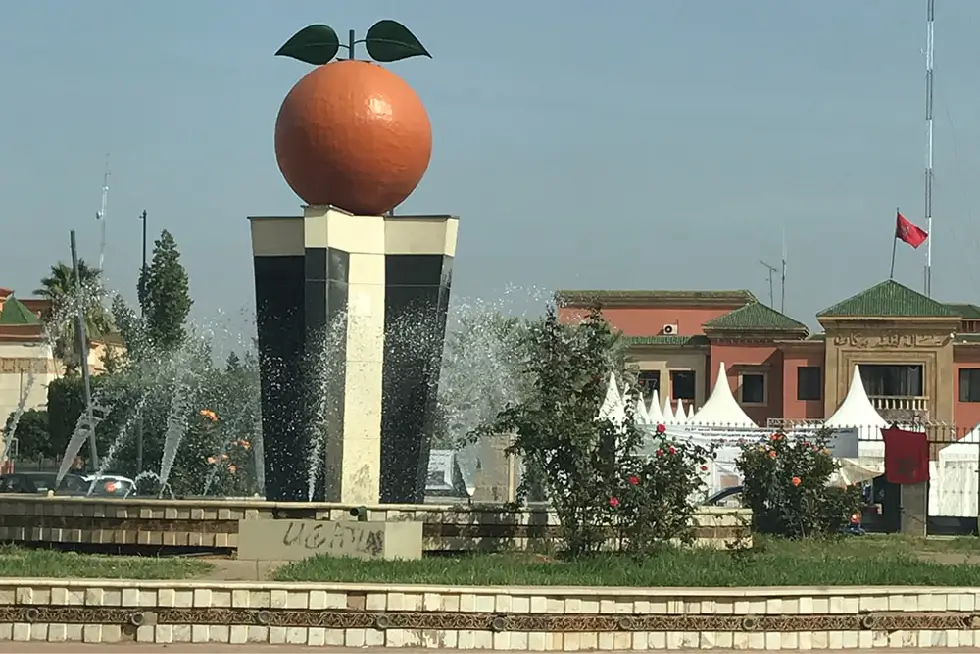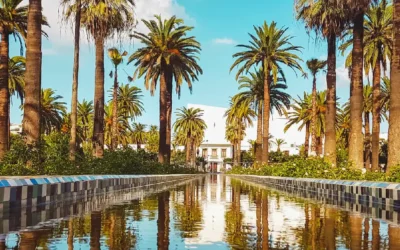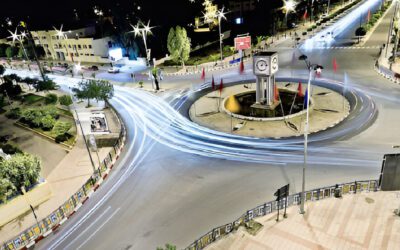Berkane: The City of Morocco known for Its Citrus (Clementines and oranges)

Table of Contents:
Introduction to Berkan City
Berkane is a city situated in the Oriental region of northeastern Morocco. Bordered by the Mediterranean Sea and the Kis River, which marks the Moroccan-Algerian border, it’s the capital of Berkane Province.
Named after its patron saint, Sidi Ahmad Aberkane, the city resonates with a deep Berber heritage, evidenced by its small population from the Aït Iznasen tribe.
The city is renowned as the capital of Morocco’s citrus fruit industry, especially known for its clementine farms—a large statue of an orange, located at the city’s center.
Berkane is a busy commercial center with lots of cafes and jewelry shops. Its growth into the surrounding hills and connections to nearby towns like Sidi Slimane amplifies its stature and significance.
Berkane Discovery Tour
Berkane offers a variety of interesting places for visitors to explore and discover. Here are some of the most popular attractions:
1. Eglise Sainte Agnes
This historical church is a significant landmark in Berkane, noted for its architectural beauty and historical significance.
2. Stade Municipal de Berkane
A key site for sports enthusiasts, this municipal stadium is a central part of the city’s sporting life.
3. Mosquee Mohammed V
This mosque is a prominent religious site in Berkane, reflecting the cultural and spiritual heritage of the region.
4. Café Riviera Ain Reggada
A popular cafe offering a relaxing ambiance and a taste of local life.
5. Parks and Nature Attractions
Berkane also features various parks and natural attractions, perfect for those looking to enjoy the outdoor beauty of the region.
6. Saidia Beach
Located approximately 18.5 km from Berkane, this beach is a popular spot for relaxation and enjoying the coastal scenery.
7. Bab Sidi Abdel Wahab
This historical site, situated around 48.1 km from Berkane, offers a glimpse into the region’s rich history.
8. Plage de Saidia
Another beach near Berkane, about 19 km away, is known for its beautiful shoreline.
9. Marina Saïdia
Offering boat tours, this marina, located 19 km from Berkane, is a great spot for water activities and exploring the coast.
10. Plage Cap de l’eau
This beach, around 22.9 km from Berkane, is known for its serene and picturesque setting.
Berkane Accessibility And Transportation
1. Effortless City Transit
Berkane’s orange taxis offer a unique and convenient way to navigate the city. These taxis are part of Morocco’s diverse taxi network, each city boasting its color scheme. For those preferring public buses, they’re an economical choice, though expect a bit of a crowd, especially during lunch hours.
2. Beyond the City: Bus and Minivan Adventures
Venture beyond Berkane with ease using the extensive bus network. For quicker trips, minivans provide a faster alternative. Both offer an authentic Moroccan travel experience at a reasonable cost.
3. Air Travel: Touching the Skies
Royal Air Maroc connects Berkane to the world, with flights from major Moroccan airports. It’s a smooth option for both domestic and international travelers.
4. Self-Drive Safari
Want to explore at your own pace? Rent a car from renowned international agencies available at airports. It’s a perfect choice for those eager to discover Morocco’s hidden gems.
Travel in Berkane is not just a journey, but an integral part of the Moroccan experience. With these options, you’re set to explore this dynamic region with comfort and ease!
Modern Berkane and its Economic Significance
1. Berkane: The Citrus Capital City of Eastern Morocco
Berkane stands as a testament to Morocco’s agricultural capability, proudly bearing the title of the citrus capital of eastern Morocco.
Its world-renowned clementines and oranges and the exceptional quality of Berkane’s citrus fruits have earned them a protected designation of origin, a mark of prestige and excellence.
2. Economic Backbone: Agriculture and Beyond
At Berkane’s core is its agriculture. The city is not just about citrus fruits; it’s also a vital player in Morocco’s grain market. Its semolina mills churn out couscous, a staple beloved in the region and beyond.
But Berkane’s economic canvas is even broader, enriched by the financial contributions of Moroccans living abroad.
3. The Commercial Heart of Berkane
Berkane’s pulse quickens in its commercial districts. Ibn Sina/Rue Dehb, also known as “The Street of Gold” or “Street of Love”, is a bustling hub, where cafes and jewelry shops jostle for attention.
This street symbolizes Berkane’s dynamic nature, seamlessly blending traditional charm with modern enterprise.
4. A City Expanding Its Horizons
The city’s expansion into the hills and its bridge connection to Sidi Slimane paint a picture of a growing, thriving community.
Berkane, more than just a dot on the map, is a beacon of economic growth and cultural richness in eastern Morocco.
Berkane History Overview
A Glimpse into Berkane’s Origins
Berkane boasts a rich history and cultural tapestry. Named after the revered Sidi Ahmad Aberkane, its population primarily descends from the Aït Iznasen tribe.
This vibrant city, speaking both Moroccan Arabic and Berber, has grown remarkably from a small community of 368 in 1917 to a bustling urban area.
Berkane’s Evolution
Originally a modest settlement, Berkane transformed into an agricultural powerhouse in the 20th century, courtesy of colonial irrigation policies.
This shift not only spurred population growth but also diversified the city’s demographic and economic landscape.
Archaeological and Cultural Significance
Steeped in history, Berkane’s roots trace back to Roman times. Near the ancient site of Tafoughalt, human presence here dates back tens of thousands of years.
Today, Berkane shines as the citrus capital of eastern Morocco, with its famed clementines earning global recognition and a protected designation of origin.
Conclusion
Berkane stands out as a shining example of Morocco’s diverse and rich cultural landscape. Its position as the citrus capital highlights not only its agricultural significance but also the ingenuity and resilience of its people.
The city’s strategic location enhances its role in both regional trade and cultural exchanges, making it a vital economic hub. The annual Orange Festival is a symbol of Berkane’s deep-rooted traditions and community spirit, drawing visitors from far and wide.
FAQ
Why is Berkane known as the capital of Morocco’s citrus fruit industry?
Berkane is renowned for its citrus fruit production, especially clementines. The city’s significance in the citrus industry is symbolized by a large statue of an orange located at its center.
What are the transportation options in Berkane?
Transportation options include orange taxis, public buses, an extensive bus network for out-of-city travel, minivans, flights via Royal Air Maroc, and car rentals from international agencies at airports.
What is Berkane and where is it located?
Berkane is a city in the Oriental region of northeastern Morocco. It’s situated near the Mediterranean Sea and the Kis River, which marks the Moroccan-Algerian border. Berkane is also the capital of Berkane Province.
What is the historical significance of Berkane?
Berkane is named after its patron saint, Sidi Ahmad Aberkane. The city has a deep Berber heritage, primarily associated with the Aït Iznasen tribe.
What are some popular attractions in Berkane?
Popular attractions include Eglise Sainte Agnes, Stade Municipal de Berkane, Mosquee Mohammed V, Café Riviera Ain Reggada, local parks and nature attractions, Saidia Beach, Bab Sidi Abdel Wahab, Plage de Saidia, Marina Saïdia, and Plage Cap de l’eau.
How has Berkane’s economy evolved?
Berkane’s economy is primarily based on agriculture, especially citrus fruits and grains. The city also benefits from the financial contributions of Moroccans living abroad. It has a thriving commercial district known for cafes and jewelry shops.
What is Berkane’s historical background?
Berkane has evolved from a modest settlement into an agricultural powerhouse. Its history dates back to Roman times, with human presence in the area for tens of thousands of years. Named after Sidi Ahmad Aberkane, it has a rich cultural tapestry rooted in the Aït Iznasen tribe.
How has Berkane’s population and the urban area changed over time?
Berkane has grown from a small community of 368 in 1917 to a bustling urban area. This growth is attributed to its transformation into an agricultural center and the subsequent diversification of its demographic and economic landscape.



